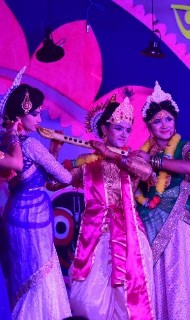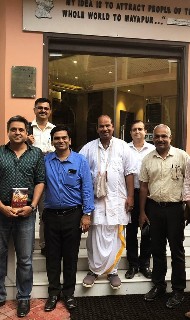Prabhupada asked if any of the devotees knew how to carve, and Shyamasundar said that he did. So Prabhupada requested him to carve three-foot-high replicas of the small Jagannatha, Balarama, and Subhadra. Shyamasundar got three large blocks of wood, and, following the sketches and directions that Prabhupada gave him, he carved the first large deities of Jagannatha, Baladeva, and Subhadra in the West.
Then Prabhupada said that the devotees should hold a Ratha-yatra festival. So, following Prabhupada’s instructions, Shyamasundar and the others arranged a flatbed truck on which they erected five tall columns and covered them with cloth to serve as a canopy over the deities. And then they decorated the “chariot” with flowers. The devotees didn’t have many vehicles then, and those they did have were pretty old and dilapidated—and unpredictable in their performance.
At the time of the first Ratha-yatra in San Francisco, Srila Prabhupada was unwell, and the devotees had rented a place for him at nearby Stinson Beach, where he could recuperate. Although Prabhupada himself was unable to attend the festival, the devotees—along with the Ratha-yatra truck, the deities, and some hippies—came to visit him the next day. They were excited and eager to report. Shyamasundar explained that while he was driving the truck up a steep hill, the truck had stalled, and although he had tried to start the engine, he couldn’t. Then the brakes had failed, and the truck had begun to roll backwards down the hill. Finally he had been able to stop it, but when he had tried to move forward, again the engine had stalled and the truck had rolled backwards. Again and again he would get it started, the truck would go forward, the engine would stall, and the truck would roll backwards. The situation had seemed hopeless, and the devotees had wondered if they would even finish the parade.
But somehow they had, and they had come to give the report. Srila Prabhupada told them the story of how Chaitanya Mahaprabhu had celebrated the Ratha-yatra in Puri. He said that in Puri too the chariot would stop, even with thousands of people pulling the ropes. The king would order powerful wrestlers and elephants to push the chariot, but still it wouldn’t move. Finally, Chaitanya Mahaprabhu would put His head on the back of the chariot and push, and only then did would the chariot move. “Now that Ratha-yatra has come to the West,” Srila Prabhupada said, “this pastime has come too.”
So, Ratha-yatra is a very ancient festival in Puri, and in ISKCON’s history it began here, in San Francisco, on a flatbed truck, in 1967. From that first Ratha-yatra, the festival has been celebrated yearly, not only in San Francisco but also in many other major cities throughout the world.
According to the Skanda Purana, the history of the installation of the Jagannatha deities in Puri goes back about a hundred and fifty-three million years. Although there is a history of how the deities came to be carved in the shapes in which they now appear, actually Lord Jagannatha and His associates are eternal. His being carved is just a pastime to facilitate His manifestation on earth. As Srila Prabhupada explains, “Fire is already present in wood, but by a certain process, fire is kindled. Similarly, God is all-pervading. He is everywhere, and since He may come out from everything, He appeared . . . Lord Nrsimha appeared from the pillar of Hiranyakasipu’s palace, Lord Varaha appeared from the nostril of Brahma, and Lord Kapila appeared from the semen of Kardama, but this does not mean that the nostril of Brahma or the pillar of Hiranyakasipu’s palace or the semen of Kardama Muni is the source of the appearance of the Lord. The Lord is always the Lord.” (SB 3.24.6 purport)
So, Lord Jagannatha is eternal, just as Krishna is eternal. Although Krishna had His appearance pastime in the prison house of Kamsa, He resides eternally on His spiritual planet, Goloka Vrindavan, and He eternally manifests His pastimes within the material world. Lord Jagannatha also has an eternal planet in the spiritual sky. He is the source of all incarnations, and He appears in whatever form His devotee wants to see Him. Sometimes in Puri the pujaris dress Him as a demigod—such as Ganesh, with an elephant’s trunk. That is also to confirm the philosophical principle that by worshiping Lord Jagannatha—Krishna—one worships all the demigods automatically. All the demigods are included in Jagannatha, and all the expansions of Godhead are included. But Chaitanya Mahaprabhu and His followers, Gaudiya Vaishnavas, see Lord Jagannatha as Krishna. When Chaitanya Mahaprabhu saw Jagannatha in Puri, He would see Krishna, Syamasundara.
The appearance of Lord Jagannatha also is mentioned in the Skanda Purana. As recounted there, Lord Jagannatha tells King Indradyumna, who had the first Jagannatha deities carved and who built the first, great temple for Lord Jagannatha in Puri, that He appeared on the full-moon day of the month of Jyestha, being pleased with the king’s devotion and sacrifices. It is on this very date every year that Snana-yatra, the public bathing of Lord Jagannatha, is held.
For the Snana-yatra in Puri, Lord Jagannatha is brought into public view on a rooftop, or terrace, of the great temple and bathed. Then, as it is said, the Lord catches a cold and is removed to His private quarters—the quarters of Lakshmi, the goddess of fortune, who for two weeks serves Him hand and foot.
Of course, that is another question, about His hands and feet. A disciple once asked Srila Prabhupada, “We are told to meditate on the Deity beginning with the lotus feet, but how do we begin our meditation on Lord Jagannatha? He doesn’t have feet.” And Srila Prabhupada replied, “You can meditate on whatever you can see.” (Advanced devotees can see Lord Jagannatha’s lotus feet.) There are philosophical principles and specific pastimes that account for why He has no feet or hands—or why they are not visible. The Upanishads say that the Lord has no legs but that He can overcome all others running. “No hands or feet” really means that He has no material hands or feet. He has spiritual hands and feet. Still, in ecstasy, He sometimes withdraws His limbs—and widens His eyes.
Krishna had so much love for the residents of Vrindavan that even in Dvaraka, in the middle of the night, He would sometimes call the names of the cowherd boys and cows, or of Srimati Radharani and the gopis, or of His mother and father, Nanda and Yasoda. Sometimes He would be so overwhelmed with ecstatic love for the residents of Vrindavan that He would not eat or sleep. It was a mystery to the residents of Dvaraka: “Who are these special people? And what is this special place, Vrindavan? What happened when Krishna was there in His childhood that makes Him so attached to them and Vrindavan?”
One person in Dvaraka had been present in Vrindavan for Krishna’s childhood pastimes: Rohini-devi, the mother of Balarama. Like Devaki, she was a wife of Vasudeva’s, but with all the atrocities being committed by King Kamsa, Vasudeva had arranged for her to stay in Vraja with Nanda and Yasoda, who were relatives and family friends. Balarama, by the arrangement of Yogamaya, had been transferred from the womb of Devaki in Mathura to the womb of Rohini in Vrindavan, and Rohini had been present for all of Balarama and Krishna’s childhood pastimes there. Wanting to hear about Krishna’s pastimes in Vrindavan, the residents of Dvaraka asked, “Who are these special people? What is this special place?” She said, “I will tell you, but no one should disturb me while I am speaking.”
So, they all assembled in a large hall in Dvaraka, and Subhadra was posted at the door to make sure that no one entered. But she too wanted to hear about Krishna’s pastimes in Vrindavan, so she put her ear to the door. Hearing Krishna’s pastimes, she became ecstatic, and in her ecstasy her eyes opened wide, her mouth smiled broadly, and her limbs withdrew. She assumed the features that we see today in the deity of Subhadra.
Then Krishna and Balarama came and saw Subhadra with her ear to the door and with those ecstatic features. And They thought, “Let Us also hear what is being said inside.” So They put Their ears to the door, and They too became ecstatic and assumed Their own particular features, with Their limbs withdrawn and Their eyes open wide and Their mouths in broad smiles. So that is how Their Lordships came to assume these special forms.
After the Snana-yatra, Lord Jagannatha retires for fifteen days, during which Lakshmi serves Him day and night. In particular, she prepares various medicinal beverages, represented by fruit juices, to help Him recover from His illness. After two weeks, Lord Jagannatha feels better, and He feels separation from His other devotees. And so, taking permission from the goddess of fortune, He embarks on a journey (yatra) in a chariot (ratha) to see them. When He doesn’t come back after three or four days—especially since He had indicated that He would be gone for only one—she becomes restless and impatient. Just imagine: Lakshmi serves Him hand and foot for two weeks, He says that He wants to go out only for the afternoon to see His other devotees, and days pass and He doesn’t come home. So she exhibits an extraordinary type of transcendental jealous pride and anger (mana), and with all opulence she proceeds with her maidservants in a procession to Sundaracala to bring back Lord Jagannatha.
The Ratha-yatra begins at the Jagannatha temple in Nilacala and proceeds to the Gundica temple in Sundaracala. Nilacala represents Dvaraka, where Krishna lives as a king and is worshiped in opulence, and Sundaracala represents Vrindavan, where Krishna is loved simply as a cowherd boy, the son of Nanda and Yasoda. During the year, the Gundica temple (named after the wife of King Indradyumna) is empty, and naturally dust and dirt accumulate. (In India most temples have an open style of architecture.) The day before Ratha-yatra is Gundica-marjana, and on that day Sri Chaitanya Mahaprabhu and His associates would thoroughly clean the Gundica temple.
As described in Sri Caitanya-caritamrta, Sri Chaitanya Mahaprabhu would gather thousands of men, and together they would clean the temple. First, with thousands of brooms, they would sweep it—twice—and then they would wash it with thousands of pots of water. They didn’t have hoses then—only pots. They would fill thousands of pots with water and wash the temple inside and out, just to make the temple fit for the Lord.
Metaphorically, the cleansing of the Gundica temple is the cleansing of the heart to make it a fit place for the Lord. Such cleansing is effected by hearing and chanting about Krishna (srnvatam sva-kathah krsnah).
srnvatam sva-kathah krsnah
punya-sravana-kirtanah
hrdy antah stho hy abhadrani
vidhunoti suhrt satam
(SB 1.2.17)
When a sincere devotee (satam) hears the messages of Krishna, all the dirty, inauspicious things (abhadrani) in the heart (hrdyantah) are cleansed (vidhunoti). Similarly, by attentive chanting and hearing of the holy names of the Lord—sankirtana—one’s consciousness is also purified (ceto-darpana-marjanam). Thus Sri Chaitanya Mahaprabhu and His followers cleaned the Gundica temple to make it a fit place for the Lord to reside. And, as Srila Prabhupada often said, “When you clean the temple, you clean your heart.”
So, five days after the Ratha-yatra, when Lord Jagannatha does not return, the goddess of fortune comes out in full force and, with her maidservants, marches on the Gundica temple. Her maidservants arrest the servants of Lord Jagannatha and bring them before her. They beat the Ratha car with sticks and treat the servants like thieves, ridiculing and abusing them. They say, “What is wrong with your master? He abandoned the opulence of the goddess of fortune for the sake of a flower garden—a few leaves and fruits and flowers. What is wrong with Him? Now bring Him before the goddess of fortune.” “Okay. Okay. Whatever you say. Tomorrow we shall bring Him.”
Thus pacified, Lakshmi returns to her abode. And Lord Jagannatha, not the next day but four days later, eventually comes, in the return Ratha-yatra. All this is very nice, but for Sri Chaitanya Mahaprabhu, who was in the mood of Srimati Radharani in separation from Krishna—the highest level of ecstatic love in separation—to not see Lord Jagannatha for two weeks was unbearable, and He almost went mad. When He had first arrived in Puri and entered the temple and seen the Deity of Jagannatha, He had thought, “Here is My Lord, for whom I’ve been searching.” He had run to embrace the Deity of Jagannatha—Krishna—and fainted in the ecstasy of pure love. So for Him to have achieved the Lord of His life and then lost Him—when Jagannatha went into seclusion—was intolerable. He could not remain in Puri. And so He walked fourteen miles west by foot to Alalanatha (Alarnath), in an area called Brahmagiri, which is named after Lord Brahma because Brahma is said to have come to earth and installed the Deity of Lord Narayana worshiped there.
But how could Chaitanya Mahaprabhu, who was in the mood of Radharani—who knows no one other than Krishna—find solace by going to Alarnath to see a four-handed Deity of Lord Narayana? Further, when Chaitanya Mahaprabhu first saw the Deity and offered prostrated obeisances, the stone slab on the temple floor beneath Him melted. In the Jagannatha temple there is a pillar called the Garuda-stambha, where Chaitanya Mahaprabhu used to stand to have darshan of Jagannatha. There are imprints of His fingers on the pillar and of His lotus feet on the floor where, in great ecstasy, He would behold Lord Jagannatha. But in Alarnath we find the unique impression of His entire body, which melted the stone when He prostrated Himself in extreme ecstasy. This is all very mysterious.
Once, during His rasa-lila at Govardhana Hill in the springtime, Sri Krishna disappeared from the scene, suggesting that He wanted to be alone with Sri Radha. He hid in a secluded bush, waiting for Her to pass by, but in the meantime the other gopis came looking for Him. They all were in the mood of separation—mad in separation from Krishna, mad in love for Krishna—having been attracted by His transcendental beauty, His charming gestures, and His loving words. They were searching all over Govardhana for Him, and finally they sighted Him in the bush. When He saw them, Krishna became struck with emotion. He could not hide Himself, and so He assumed His four-armed Narayana form. When the gopis saw Lord Narayana, they said, “Oh, He is not Krishna. He is Lord Narayana, the Supreme Personality of Godhead.” They had no interest in Lord Narayana; they were interested only in Krishna. So they offered Him respects and prayed, “Please bless us with Krishna’s association.” Otherwise, they had no use for Him. They went on searching for Krishna. Then, when Srimati Radharani came, Krishna wanted to maintain His four-armed form to joke with Her, but although He tried His best, He was unable to do so. The influence of Her ecstatic love forced Him to return to His original two-armed form. He couldn’t maintain His feature as Lord Narayana. He was conquered by Srimati Radharani’s love and so revealed His original form as Krishna.
rasarambha-vidhau niliya vasata kunje mrgaksi-ganair
drstam gopayitum svam uddhura-dhiya ya susthu sandarsita
radhayah pranayasya hanta mahima yasya sriya raksitum
sa sakya prabhavisnunapi harina nasic catur-bahuta
“Prior to the rasa dance, Lord Krsna hid Himself in a grove just to have fun. When the gopis came, their eyes resembling those of deer, by His sharp intelligence He exhibited His beautiful four-armed form to hide Himself. But when Srimati Radharani came there, Krsna could not maintain His four arms in Her presence. This is the wonderful glory of Her love.” (Ujjvala-nilamani, Nayika-bheda 7)
Transcendentally, Alarnath in Chaitanya’s lila in Puri is compared to Paitha at Govardhana. It is a place of intense separation. The gopis, in separation from Krishna, roamed the forest there, looking for Him. And Paitha is the place where Lord Narayana wasn’t really Lord Narayana. He was actually Krishna assuming the form of Narayana to play a joke on the gopis—and to bring out their exclusive love for Him. Thus, although the external form of the Deity of Lord Alarnath is that of four-armed Narayana, internally He is Krishna. And the pujaris of Alarnath admit that in their worship they recite very confidential mantras to Krishna, the lover of Srimati Radharani.
During those fourteen days, called anavasara, when Lord Jagannatha retires to His private quarters and receives service from Laksmi, Sri Chaitanya Mahaprabhu, in separation, went to Alarnath.
So, there are many deep feelings connected to Ratha-yatra. This whole pastime—like all the pastimes of Jagannatha in Puri—is very deep and full of separation. Jagannatha Puri is vipralambha-dhama. Vipralambha means “separation.” Lord Jagannatha, in His opulent temple, feels separation from Srimati Radharani and His other pure devotees in Vrindavan. And Sri Chaitanya Mahaprabhu, in the mood of Srimati Radharani after Krishna left Vrindavan for Mathura and Dvaraka, also feels separation. So Jagannatha Puri is a place of crying. But that crying is ecstasy. That separation is ecstasy. It is not what we experience in the material world.
After this period of separation, when Lord Jagannatha finally leaves His private quarters, He emerges from the temple and mounts His chariot—and for the first time in two weeks Chaitanya Mahaprabhu and the other devotees are able to see Him. So they become ecstatic. And in the Ratha-yatra, Sri Chaitanya Mahaprabhu is in the mood of Radharani bringing Krishna back to Vrindavan.
As described in Srimad-Bhagavatam, after Krishna had been living as a king in Dvaraka for many years, He was informed that there was going to be a solar eclipse. To observe the eclipse, Krishna announced that He would go to Kurukshetra, a holy place (dharma-ksetra kuru-ksetra) in North India. The Vedas recommend that one go to Kurukshetra to perform the various rituals associated with eclipses—to bathe in the sacred waters, perform sacrifices, give charity, and so on. When the news reached the residents of Vrindavan that Krishna was going to Kurukshetra, they thought, “Let us go, too.” They weren’t interested in the ritual baths or ceremonies. They were interested in Krishna. Since He had left Vrindavan, they had been feeling intense separation. Their only business had been crying for Krishna. They decided, “We shall also go.” And so they went.
It was a very touching scene when Krishna met the residents of Vrindavan—heart rending. Although He first met the elders, beginning with Nanda and Yasoda and their associates, within His heart He was thinking of Radharani and the gopis. So He took an opportunity to steal away from the others to meet them. Yet although Radha was seeing Krishna, it wasn’t the same. She said, “You’re the same Krishna, and I am the same Radha, but it’s not the same here. Please come back to Vrindavan. Here there are crowds of people, elephants, and horses, and the rattling of chariots. In Vrindavan there are flower gardens and the chirping of birds and the humming of bees. Here You are dressed like a royal prince with all sorts of opulent paraphernalia, accompanied by great warriors. In Vrindavan You appeared just like a cowherd boy, dressed in Your yellow dhoti (pitambara) and decorated with a peacock feather, accompanied only by Your flute. Here in Kurukshetra there is not even a drop of the ocean of transcendental happiness that I enjoyed with You in Vrindavan. So please come back to Vrindavan, and let Us relish pastimes as We did in Our youth.”
In that mood of Srimati Radharani, Sri Chaitanya Mahaprabhu, dancing in front of Lord Jagannatha in the Ratha-yatra, would recite a verse from a romantic poem:
yah kaumara-harah sa eva hi varas ta eva caitra-ksapas
te conmilita-malati-surabhayah praudhah kadambanilah
sa caivasmi tathapi tatra surata-vyapara-lila-vidhau
reva-rodhasi vetasi-taru-tale cetah samutkanthate
“That very personality who stole away my heart during my youth is now again my master. These are the same moonlit nights of the month of Caitra. The same fragrance of malati flowers is there, and the same sweet breezes are blowing from the kadamba forest. In our intimate relationship, I am also the same lover, yet still my mind is not happy here. I am eager to go back to that place on the bank of the Reva under the Vetasi tree. That is my desire.” (Padyavali 386; Cc Madhya 1.58, 13.121)
That emotional pulling of Krishna from Kurukshetra to Vrindavan is the mood of Sri Chaitanya Mahaprabhu in the Ratha-yatra. There is so much reciprocation between Lord Chaitanya and Lord Jagannatha based on Srimati Radharani and the gopis pulling Krishna back to Vrindavan. Sometimes Chaitanya Mahaprabhu went ahead, and Lord Jagannatha, astonished by the dancing of Sri Chaitanya Mahaprabhu, stopped His chariot to watch. Sometimes Chaitanya Mahaprabhu stayed behind the chariot, and eventually Lord Jagannatha would stop. Then Chaitanya Mahaprabhu would come forward, and then Lord Jagannatha would move forward, too.
ei-mata gaura-syame, donhe thelatheli
svarathe syamere rakhe gaura maha-bali
“Thus there was a sort of competition between Caitanya Mahaprabhu and Lord Jagannatha in seeing who would lead, but Caitanya Mahaprabhu was so strong that He made Lord Jagannatha wait in His car.” (Cc Madhya 13.119)
Srila Prabhupada, citing Srila Bhaktisiddhanta’s commentary, explains that Sri Chaitanya Mahaprabhu’s leading Lord Jagannatha toward the Gundica temple corresponded to Srimati Radharani’s leading Krishna toward Vrindavan. Sri Chaitanya Mahaprabhu’s following at the rear of the chariot indicated that Lord Jagannatha, Krishna, was forgetting the inhabitants of Vrindavan. In the role of Srimati Radharani, Sri Chaitanya Mahaprabhu was examining whether the Lord still remembered the inhabitants of Vrindavan. “When Caitanya Mahaprabhu fell behind the Ratha car, Jagannatha-deva, Krsna Himself, understood the mind of Srimati Radharani. Therefore, Jagannatha sometimes fell behind the dancing Sri Caitanya Mahaprabhu to indicate to Srimati Radharani that He had not forgotten. Thus Lord Jagannatha would stop the forward march of the ratha and wait at a standstill. . . . While Jagannatha was thus waiting, Gaurasundara, Caitanya Mahaprabhu, in His ecstasy of Srimati Radharani, immediately came forward to Krsna. At such times, Lord Jagannatha would proceed ahead very slowly. These competitive exchanges were all part of the love affair between Krsna and Srimati Radharani.” (Cc Madhya 13.119 purport)
Ultimately Jagannatha reaches Vrindavan, the Gundica temple. There is so much feeling in these festivals.
Now we shall read about Snana-yatra from Sri Caitanya-caritamrta, not only to hear directly from Srila Prabhupada about Snana-yatra, but also to realize what an unlimited wealth of knowledge—of nectar—exists in Prabhupada’s books. I am going to read four or five verses—out of hundreds and thousands—and yet in just these few verses there is so much nectar.
jaya jaya sri-caitanya jaya nityananda
jayadvaita-candra jaya gaura-bhakta-vrnda
We shall read from Sri Caitanya-caritamrta, Madhya-lila, Chapter One: “The Later Pastimes of Lord Caitanya.” In verse 121, the author, Srila Krsnadasa Kaviraja Gosvami, mentions that Lord Chaitanya witnessed the Snana-yatra festival. He continues:
TEXT 122
anavasare jagannathera na pana darasana
virahe alalanatha karila gamana
TRANSLATION
When Jagannatha was absent from the temple, Caitanya Mahaprabhu, who could not see Him, felt separation and left Jagannatha Puri to go to a place known as Alalanatha.
PURPORT by Srila Prabhupada
Alalanatha is also known as Brahmagiri. This place is about fourteen miles from Jagannatha Puri and is also on the beach. There is a temple of Jagannatha there. At the present moment a police station and post office are situated there because so many people come to see the temple.
The word anavasara is used when Sri Jagannathaji cannot be seen in the temple. After the bathing ceremony (snana-yatra), Lord Jagannatha apparently becomes sick. He is therefore removed to His private apartment, where no one can see Him. Actually, during this period renovations are made on the body of the Jagannatha Deity. This is called nava-yauvana.
COMMENT
Nava-yauvana means “ever-fresh,” or “always youthful.” At this time the Jagannatha Deity is fully restored to youth.
PURPORT (continued)
During the Ratha-yatra ceremony, Lord Jagannatha once again comes before the public. Thus for fifteen days after the bathing ceremony, Lord Jagannatha is not visible to any visitors.
TEXT 123
bhakta-sane dina kata tahani rahila
gaudera bhakta aise, samacara paila
TRANSLATION
Sri Caitanya Mahaprabhu remained for some days at Alalanatha. In the meantime, He received news that all the devotees from Bengal were coming to Jagannatha Puri.
COMMENT
Every year, the devotees from Bengal would travel by foot to Jagannatha Puri for the Ratha-yatra and the four months of the rainy season called Caturmasya.
TEXTS 124-125
When the devotees from Bengal arrived at Jagannatha Puri, both Nityananda Prabhu and Sarvabhauma Bhattacarya greatly endeavored to take Sri Caitanya Mahaprabhu back to Jagannatha Puri.
When Lord Caitanya Mahaprabhu finally left Alalanatha to return to Jagannatha Puri, He was overwhelmed both day and night due to separation from Jagannatha. His lamentation knew no bounds. During this time, all the devotees from different parts of Bengal, and especially from Navadvipa, arrived in Jagannatha Puri.
TEXT 126
sabe mili’yukti kari’ kirtana arambhila
kirtana-avese prabhura mana sthira haila
TRANSLATION
After due consideration, all the devotees began chanting the holy name congregationally. Lord Caitanya’s mind was thus pacified by the ecstasy of the chanting.
PURPORT
Being absolute in all circumstances, Lord Jagannatha’s person, form, picture, and kirtana are all identical. Therefore when Caitanya Mahaprabhu heard the chanting of the holy name of the Lord, He was pacified. Previously, He had been feeling very morose due to separation from Jagannatha. The conclusion is that whenever a kirtana of pure devotees takes place, the Lord is immediately present. By chanting the holy names of the Lord, we associate with the Lord personally.
COMMENT
This is a very important lesson. Chaitanya Mahaprabhu was in such deep separation from Jagannatha that He could not do anything or think of anything else. Finally the devotees decided to perform kirtan. By chanting the holy names of Krishna, who is Lord Jagannatha, Chaitanya Mahaprabhu felt pacified, because He was experiencing the association of Jagannatha through the holy name.
As Prabhupada mentions here in the purport, the holy name of Krishna—the holy name of Jagannatha—is the same as Krishna. Seeing the form of Lord Jagannatha and hearing the name of Lord Krishna—the name of Lord Jagannatha—are the same. In one sense, all service is absolute. There is no difference between worshiping the form of the Lord and chanting the name of the Lord. But to engage in Deity worship, there are so many requirements. You need deities; you must be clean; you must be initiated; you must know the mantras; you must have the paraphernalia—sixteen different types of items to offer—you require so many things. But with chanting you don’t require anything. As Srila Prabhupada said, all you require is your tongue and your ears. You don’t even require your mind. In fact, it is better to leave your mind out of it. Once, a disciple asked Srila Prabhupada, “What do I do with my mind when I chant?” And Prabhupada said, “Your mind? What is the question of mind? With your tongue you chant and with your ears you hear.” With our tongue we chant, with our ears we hear, and with our intelligence we remain fixed.
By the kirtan of pure devotees, by chanting and hearing, we associate with Krishna. And all of our feelings of separation can be mitigated. The holy names of Krishna include everything. His names, His forms, His qualities, His pastimes, His paraphernalia, His entourage—all are included. Srila Prabhupada and his parampara are also included. The whole spiritual world is included. Everything is revealed when we chant and hear with attention, chant and hear with love.
Now the devotees here will be suffering in separation from Lord Jagannatha for fifteen days. But we can take shelter of the holy names of Lord Jagannatha and read the pastimes of Lord Jagannatha and Sri Chaitanya Mahaprabhu in Sri Caitanya-caritamrta. And we can read about Srila Prabhupada and Ratha-yatra in Srila Prabhupada-lilamrta. We should read these books. They are important. Prabhupada stayed up all night to write his books. He would take rest at ten o’clock and get up at twelve o’clock and write these books, not just for us to sell—of course, it is good that we sell them—but for us to read; we should also read them. As he said, “Distributing my books will keep them [devotees] happy, and reading my books will keep them.” Reading will keep us fixed. So we need to do all these things. We can’t afford to waste a moment. As Prabhupada said, “Don’t talk nonsense. Don’t waste time. If you have got time, chant Hare Krishna.”
[A talk by Giriraj Swami on July 13, 2008, in Berkeley, California]


 By Mukhya devi dasi
By Mukhya devi dasi 











 By Urmila Devi Dasi
By Urmila Devi Dasi By Srigarbha das
By Srigarbha das By TOVP staff
By TOVP staff



 By Chandan Yatra Das
By Chandan Yatra Das By Leicester City Council
By Leicester City Council By Purushottam Nitai Das
By Purushottam Nitai Das
